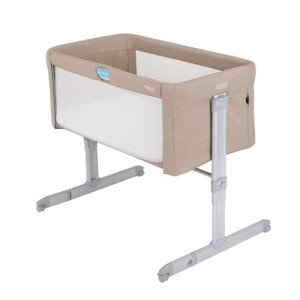The Benefits and Considerations of Bedside Cots for Co-Sleeping
Co-sleeping has emerged as a popular option for many new parents who seek to preserve close proximity to their infants throughout the night. In addition to standard co-sleeping practices, bedside cots are getting traction as an alternative that provides both the comfort of nearness and the security of separate sleeping spaces. This post aims to check out the idea of bedside cots for co-sleeping, highlighting their advantages, possible drawbacks, ideas for selection, and typical issues.
Comprehending Bedside Cots
Bedside cots, likewise known as side-sleepers or co-sleepers, are specially designed cribs that are attached to the side of the parents' bed. They permit parents to keep easy access to their infants at night while offering a separate sleeping location that can boost security and comfort.
Functions of Bedside Cots
- Size and Design: Bedside cots are often smaller sized than basic cribs however still provide sufficient room for an infant. The majority of designs have adjustable heights to match the bed.
- Side Panels: Many models include removable or mesh side panels that permit safe visual tracking of the baby, improving parents' ability to react to their baby's requirements quickly.
- Stability and Safety: Bedside cots are developed with stability in mind, including security anchors or straps that protect the cot to the moms and dad's bed.
- Ease of Access: Parents can quickly reach over to comfort or feed their baby without needing to get out of bed, facilitating nighttime breastfeeding or relaxing.
Benefits of Using Bedside Cots for Co-Sleeping
- Boosted Bonding: Proximity to the baby cultivates emotional connection and bonding, which is essential throughout the early stages of development.
- Easier Nighttime Care: Nighttime feeding and reassuring become significantly simpler with a bedside cot, as parents can just lean over to participate in to their baby's needs.
- Increased Safety: Bedside cots minimize the threat of suffocation or accidental rolls that can accompany standard co-sleeping directly in the parental bed.
- Specific Sleep Space: The documents supports that having their own sleeping space can assist infants sleep better in terms of fewer disruptions from parents.
- Transitioning: A bedside cot can be a handy transitional tool as babies grow and begin to relocate to their own rooms.
| Feature | Advantages |
|---|---|
| Boosted Bonding | Closer physical existence |
| Easier Access | Quick response to needs |
| Increased Safety | Lowered risk of mishaps |
| Private Space | Less disruption during the night |
| Streamlined Transition | Much easier relocate to independent sleeping |
Considerations Before Choosing a Bedside Cot
While bedside cots offer various benefits, prospective users need to consider the following elements:
- Size of Bed: Ensure that the cot fits surrounding to the bed without triggering discomfort or overcrowding.
- Spending plan: Prices can differ substantially amongst different brands and models, so think about spending plan constraints thoroughly.
- Security Standards: Check that the cot fulfills all safety policies to ensure it is free from harmful products and includes essential security functions.
- Product: Non-toxic surfaces and products are crucially important for infant health.
- Infant's Age and Weight: Some cots have weight limitations, and parents need to select accordingly based on their baby's growth.
Tips for Selecting a Bedside Cot
- Read Reviews: Look for user feedback and security rankings.
- Examine for Certifications: Ensure the cot complies with security standards.
- Examine the Design: Choose a design that complements your bedroom design while ensuring functionality.
- Think about Accessibility: Look for designs that allow easy reach but lessen the threat of rolling out.
- Test Stability: Ensure that the cot is steady and safe when connected to the bed.
Typical FAQs About Bedside Cots for Co-Sleeping
Q1: Are bedside cots safe for co-sleeping?
A1: When utilized correctly, bedside cots are developed to offer a safe sleeping option for infants while enabling close proximity to parents. Constantly guarantee to protect Bedside Cot For Close Bonding to prevent movements that might lead to mishaps.
Q2: At what age can I begin using a bedside cot?A2: Many parents start utilizing bedside cots right after the baby is born. Nevertheless, it is important to talk to a doctor regarding your infant's readiness for co-sleeping, particularly if they were born too soon. Q3: Can I use a regular
crib for co-sleeping? A3: While regular cribs can be used, they do not provide the very same level of availability and security as bedside cots, making bedside alternatives more favorable for co-sleeping. Q4: What if my baby rolls over?A4: Most bedside cots are created with security features that lessen risks if a baby rolls. Furthermore,
they are usually low enough that a roll would not result in a substantial drop. Q5: How do I transition my baby from a bedside cot to a regular crib?A5: Gradually move your baby to a separate crib in their own room after they become accustomed to oversleeping the bedside cot. Start with naps in the crib while maintaining nighttime co-sleeping up until they adapt. Bedside cots provide a useful and much safer option to direct co-sleeping, offering many advantages in terms of convenience and safety. They help with bonding
in between infants and parents while minimizing the dangers associated with traditional co-sleeping practices. Parents searching for a way to keep their babies close in the evening should consider the benefits that bedside cots can provide. With a mindful assessment of choices available, parents can develop a safe and comfortable sleep environment that supports their household's unique requirements.

